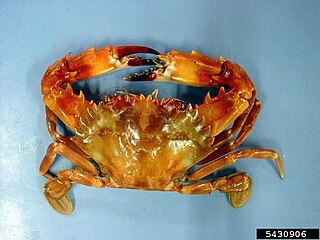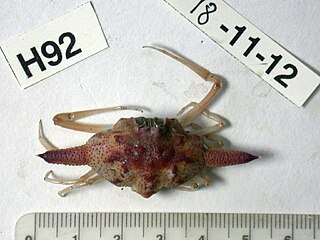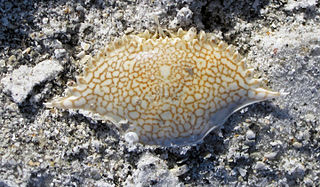
Crabs are decapod crustaceans of the infraorder Brachyura, which typically have a very short projecting "tail" (abdomen), usually hidden entirely under the thorax. They live in all the world's oceans, in fresh water, and on land, are generally covered with a thick exoskeleton, and have a single pair of pincers. They first appeared during the Jurassic Period.

Portunidae is a family of crabs which contains the swimming crabs.

Hemigrapsus crenulatus, the hairy-handed crab or papaka huruhuru, is a marine crab of the family Varunidae, endemic to the New Zealand coast, although a taxon in Chile may be conspecific. It is an intertidal species with semi-terrestrial tendencies. They are named by their characteristic setae, or patches of thick hair, on the chelipeds and legs. They can range from green to brown in coloration. Adult crabs are generally 2–4 cm (0.8–1.6 in) wide at the carapace, although the smallest mature crabs can be around just 1 cm (0.4 in) wide. and are able to survive and reproduce in environments of widely varying salinities.

Charybdis is a genus of swimming crabs in the family Portunidae; "Charybdis" is Greek for whirlpool.

Portunoidea is a superfamily of crabs that includes the family Portunidae, the swimming crabs. Which other crab families are also placed here is a matter of some contention, and may be revised following molecular phylogenetic analyses.

Latreilliidae is a small family of crabs. They are relatively small, long-legged crabs found on soft bottoms at depths of up 700 metres (2,300 ft) in mostly tropical and subtemperate waters around the world. Their carapace is very small and doesn’t cover the bases of their legs, which protrude from the cephalothorax in a spider-like manner. The family and its type genus are named after Pierre André Latreille. The oldest known fossils from the Latreillidae have been dated to the middle of the Cretaceous period. It comprises seven extant species.

Percnon gibbesi is a species of crab. It is one of at least two species commonly called "Sally Lightfoot", and is also referred to as the nimble spray crab or urchin crab. It has been described as "the most invasive decapod species to enter the Mediterranean".

Matutidae is a family of crabs, sometimes called moon crabs, adapted for swimming or digging. They differ from the swimming crabs of the family Portunidae in that all five pairs of legs are flattened, rather than just the last pair, as in Portunidae. Crabs in the Matutidae are aggressive predators.

Xantho poressa, the jaguar round crab, is a species of crab from the eastern Atlantic Ocean. It is one of four species in the genus Xantho.

Charybdis natator, the ridged swimming crab, wrinkled swimming crab or rock crab, is a widespread Indo-Pacific species of swimming crab from the genus Charybdis. It gets its name from the ridges on the dorsal surface of the carapace. It is a crab species which is of minor importance in fisheries.
Atergatis roseus, the rosy egg crab, is a species of reef crab from the family Xanthidae with a natural range extending from the Red Sea to Fiji. It has colonised the eastern Mediterranean by Lessepsian migration through the Suez Canal. The flesh of this crab, like many other species in the family Xanthidae, is toxic.

Charybdis hellerii, the Indo-Pacific swimming crab or spiny hands is a species of crab from the swimming crab family, the Portunidae. Its native range covers the Indian and Pacific Oceans but it has been introduced to the western Atlantic and has invaded the Mediterranean. It is a commercially exploited species in south-east Asia.

Actea savignii is a species of Indo-Pacific crab from the family Xanthidae which is one of the spiny-legged rock crabs. It has colonised the Levantine Sea by Lessepsian migration through the Suez Canal from the Red Sea since the mid 2000s.

Hyastenus hilgendorfi is a species of spider crab from the family Epialtidae, classified in the sub-family Pisinae, from the Indo-Pacific region. It has been recorded in the Suez Canal and there have been a few records in the eastern Mediterranean, making it a Lessepsian migrant.

Ixa monodi, the Red Sea pebble crab is a species of pebble crab from the family Leucosiidae which prefers to burrow in sandy, shallow coastal waters. It was first described from the eastern Mediterranean where it is an invasive species having colonised the coasts of the Levantine Sea from the Red Sea by Lessepsian migration from the Red Sea via the Suez Canal.
Jentina E. Leene was a Dutch scientist who had an early career in zoology, specifically carcinology, was a science teacher and then a textile scientist. Her zoological work was highly regarded, especially her doctoral thesis on the swimming crabs of the genus Charybdis.

Heterosaccus is a genus of barnacles in infraclass Rhizocephala. Like other taxa in this group, they parasitize crabs. Geoffroy Smith circumscribed the genus in 1906; he initially only included H. hians. Smith circumscribed a genus distinct from Sacculina due to a difference of the mesentery; in Heterosaccus, the mesentery does not stretch down to the mantle opening but rather only is present on the ring of attachment.

Tubuca alcocki is a species of fiddler crab. Its range includes most of the northern Indian Ocean, from western Thailand, through the Bay of Bengal and India, to the Red Sea.

Arenaeus cribrarius, the speckled swimming crab, is a species of swimming crab in the family Portunidae.
















